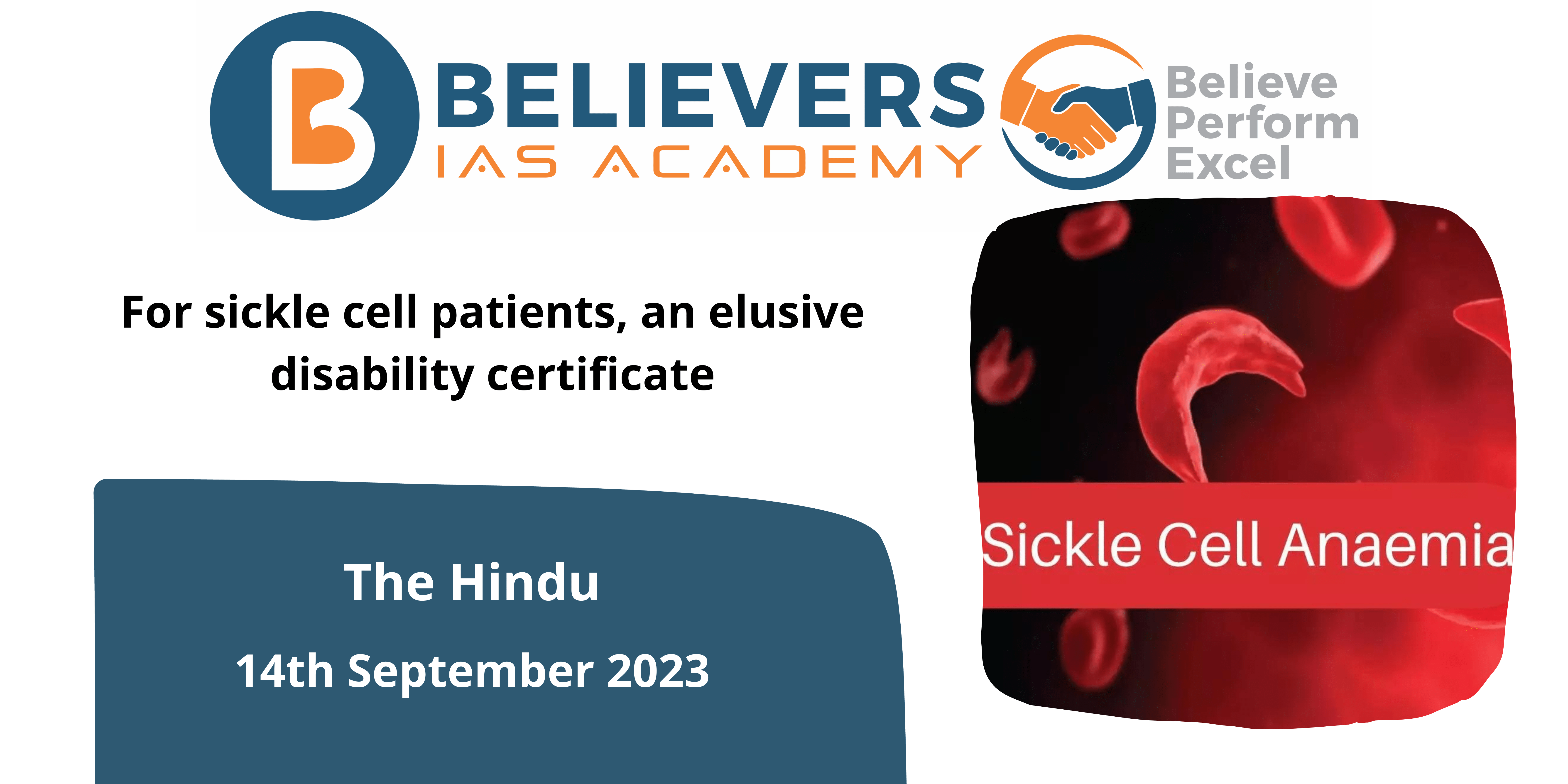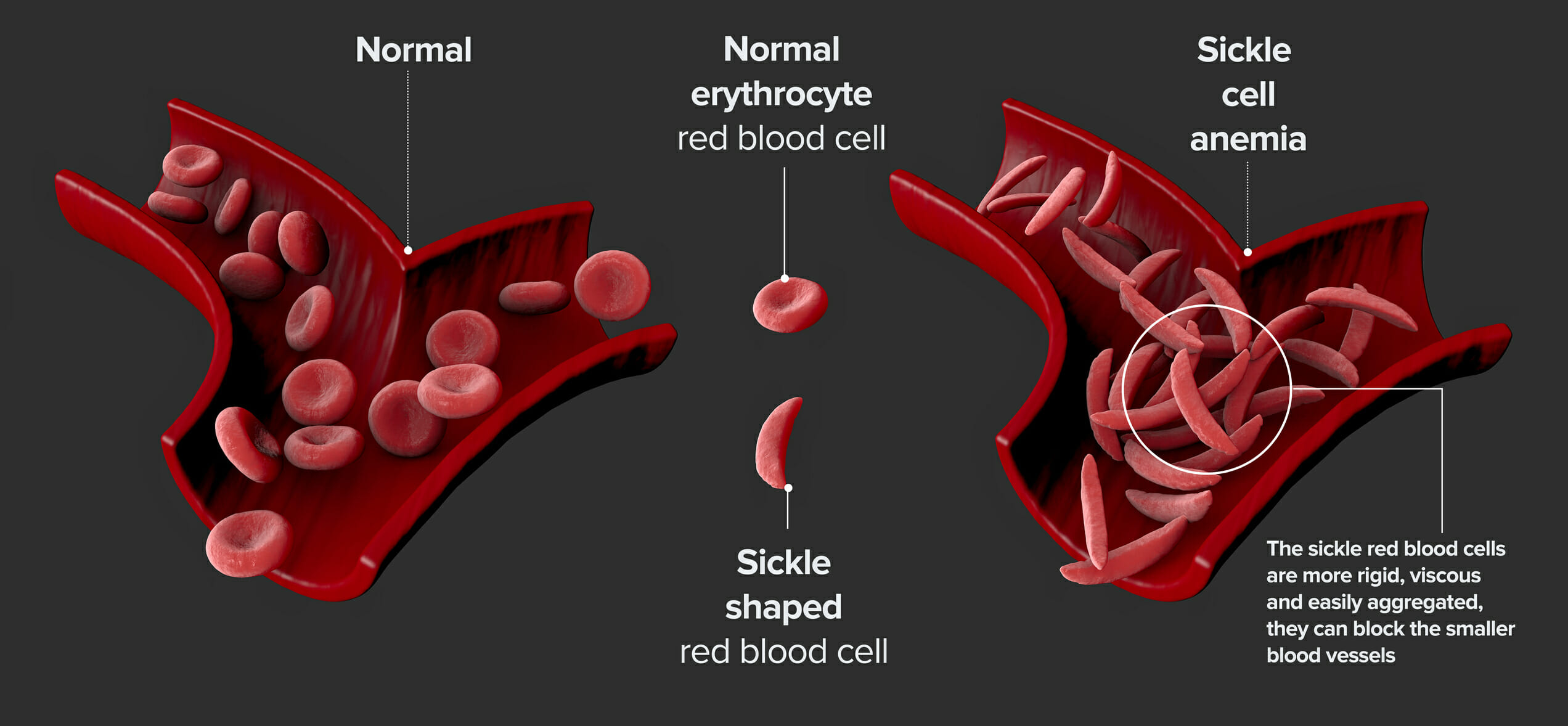For sickle cell patients, an elusive disability certificate
Context
At three Union Ministries, a plan to issue permanent disability certificates to sickle-cell disease patients older than five has been bogged down for nearly three years. A Standing Committee of the Parliament encouraged the government to act quickly in a report that was presented during the Monsoon Session of the House of Representatives.
What is sickle cell anaemia?
- Sickle cell anaemia is a type of sickle cell disease, a group of inherited blood disorders. Two defective beta-globin gene copies, one from each parent, are the cause of sickle cell disease. Hemoglobin S, a flawed haemoglobin protein, results from this. Flexible red blood cells become rigid, sickle-shaped cells when haemoglobin S is present. These sickle cells can obstruct blood flow, which can harm organs and cause pain.
- The following are signs of sickle cell anaemia:
- skin tone or eye whites that are yellow-coloured
- excessive sluggishness or fussiness
- Hands and feet that are painfully swollen
- Millions of people throughout the world suffer from sickle cell disease. People with sub-Saharan African ancestry, those from Spanish-speaking parts of the Western Hemisphere, Saudi Arabia, India Mediterranean countries and Kuwait are particularly prone to it.
Which part of the society is most affected by the disease?
- Tribal groups in India are more likely to have sickle cell disease. Maharashtra, where the illness burden in the country is estimated to be at 29.8%, is where the disease is most common. The Vidarbha area, which includes all of Maharashtra’s eastern districts, is characterized by a high prevalence of the sickle gene. Additionally, it is common in several areas of Marathawada and the northern Satpura mountains.
- In the Nilgiri Hills of northern Tamil Nadu, the sickle cell gene was originally identified in 1952. Between 0% and 35% of members of certain tribes are sickle cell carriers.
- Anaemia, pain flare-ups, stunted growth, and damage to numerous organs, including the lungs, heart, kidneys, eyes, bones, and brain, are all symptoms of sickle cell disease. In India, almost 20 million people have a diagnosed with sickle cell Disease.
What is the campaign that the government introduced to eradicate SCD?
- The campaign to “eradicate” SCD in India by 2047 has been started by the Union government. But at the moment, only disability certificates with a three-year validity are acceptable for SCD sufferers.
- To eradicate sickle cell disease (SCD) in India by the year 2047, there is a nationwide initiative called the National Sickle Cell Anaemia Elimination Mission (NSCAEM). The Prime Minister included a statement on the mission in the budget for 2023–24. The mission attempts to solve SCD’s health concerns, particularly those faced by the indigenous community.
- This mission will:
- Spread knowledge about the prevention and treatment of sickle cell anaemia among the general public and healthcare professionals.
- Improve the facilities and services available to SCD patients to improve their quality of life.
- Follow up with sick people frequently
- By 2047, the project hopes to have made sickle cell disease no longer a concern for the general public.
What is the certificate given to SCD patients?
- The standards and regulations for disability certificates are established by the Health Ministry. These certificates, which are necessary to be eligible for reservations and benefits under different government programs are issued by the Social Justice and Empowerment Ministry.
- Ministry of Tribal Affairs Concern: Due to the degenerative nature of SCD and its prevalence among tribal communities, the Tribal Affairs Ministry is concerned about making sure that people with SCD receive permanent disability certificates.
- Certificate Validity Changes: Patients could initially only obtain one-year disability certificates. The option of granting permanent disability certificates was brought up in 2020, and the period of validity was extended to three years for people with a minimum of 25% disability.
What is the current goal of the government in the eradication of SCD?
- The present objective of the Indian government is to “eradicate” SCD in India.
- Timeline: 2047 is the intended year of completion.
- Publicized Campaign: To battle SCD, the government has started a public campaign that emphasizes the necessity of curing the illness.
- The Health Ministry is currently concentrating on the early detection of SCD. In 17 states and union territories, an initiative to screen seven crore (70 million) tribal individuals for SCD is involved
- Government efforts are being made to lower the prevalence of SCD in addition to detection and preventative efforts.
What is the way forward?
- Issuance of Permanent Disability Certificates: The government should give SCD patients, especially those older than five, the top priority when issuing permanent disability certificates. This is crucial to make sure they have access to the benefits, reservations, and support systems they require.
- suggestions of the Expert Committee: The Health Ministry should go over the expert committee’s suggestions after hearing their thoughts on disability certificates from stakeholders and SCD sufferers. The Health Ministry should consider these recommendations if the committee has suggested permanent disability certificates.
- Collaboration Among Ministries: To expedite the process of awarding disability certificates for SCD patients, the several ministries concerned, including the Health Ministry, the Social Justice and Empowerment Ministry, and the Tribal Affairs Ministry, should cooperate. To increase the process’s effectiveness, clear rules and procedures should be set.
- Awareness and Education: It is important to spread information about SCD to the general public, healthcare professionals, and tribal communities. This contains details on its causes, symptoms, and precautions
- Early Detection and Prevention: Screening tribal communities for SCD is an ongoing project that is a good first step. The government should keep funding initiatives for early detection and prevention, such as genetic counselling and disease management training.





